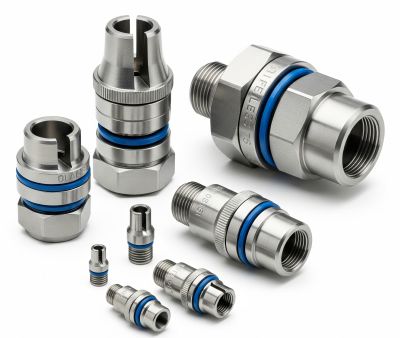Hydraulic systems are the lifeblood of mobile and industrial machinery. From construction vehicles and agricultural tractors to manufacturing lines and heavy-duty presses, these systems rely on the precise transmission of fluid under pressure. To keep everything running smoothly and safely, every connection point must be robust, leak-free, and capable of withstanding extreme operating conditions.
That’s where flareless bite type fittings come in. These fittings are engineered to deliver secure, high-pressure connections without the need for tube flaring, making them a preferred choice in both mobile and industrial applications. This blog will walk you through what they are, why they stand out, and how to get the best performance from them.
What Are Flareless Bite Type Fittings?
Flareless bite type fittings are a type of mechanical fitting used to connect tubes in hydraulic systems. Unlike flared fittings that require the end of a tube to be flared outward, flareless fittings use a cutting or “biting” action to secure the tube.
Key Components:
➡️ Body: The main housing that receives the tubing.
➡️ Sleeve (Ferrule): Bites into the tube when compressed, creating a tight seal.
➡️ Nut: Screws onto the body and compresses the sleeve onto the tube.
The “bite” mechanism cuts slightly into the outer diameter of the tube, forming a metal-to-metal seal that resists pressure and vibration. This design simplifies the assembly process while offering robust performance.
What is the Difference Between Flare and Flareless Fittings?
|
Feature |
Flared Fittings |
Flareless Bite Type Fittings |
|
Tube End Preparation |
Requires flaring tool |
No flaring needed |
|
Seal Type |
Flared metal surface |
Ferrule bite on tube |
|
Assembly Time |
Longer |
Faster |
|
Suitability |
Lower to moderate pressure |
High-pressure systems |
In short, flareless fittings reduce prep time and eliminate the need for special flaring equipment, making them ideal for fast-paced or remote installations.
Advantages of Flareless Bite Type Fittings
Easy and Efficient Installation
One of the biggest advantages of flareless fittings is their ease of installation. Since there’s no need to flare the tube, you save time and reduce the need for specialized tooling. Simply cut the tube square, deburr it, and assemble the fitting.
High Pressure Capability
Flareless bite-type fittings are built to handle high-pressure applications, often exceeding 6000 PSI, depending on the size and material. The bite mechanism creates a strong mechanical grip that performs well even under vibration, thermal cycling, or pressure surges.
Leak-Free Performance
Thanks to their secure metal-to-metal seal, these fittings greatly reduce the chance of hydraulic fluid leaks. This is especially important in mobile equipment and industrial settings where leakage can lead to downtime, safety hazards, or environmental issues.
Versatile Material Compatibility
Flareless fittings work with a range of tubing materials including carbon steel, stainless steel, and even softer metals like copper or aluminum (depending on sleeve design). This makes them suitable for corrosive or high-temperature environments such as marine, offshore, and chemical processing applications.
Applications in Mobile and Industrial Equipment
Mobile Equipment
In mobile machinery such as excavators, backhoes, and tractors, hydraulic systems are constantly subjected to vibration, movement, and changing pressure conditions. Flareless fittings offer a stable, long-lasting connection that reduces the likelihood of failures in the field.
Industrial Equipment
In industrial settings like CNC machines, hydraulic presses, and factory automation lines, reliability and ease of maintenance are top priorities. Flareless bite type fittings require less frequent attention and are easier to replace without disrupting production, saving both time and cost.
How to Select the Right Flareless Bite Type Fitting
Choosing the right fitting involves several key considerations:
➡️ Pressure Rating: Ensure the fitting can handle your system’s maximum pressure.
➡️ Tube Material: Match the fitting to the correct material for proper bite and sealing.
➡️ Sizing: Follow standard sizing charts (e.g., DIN 2353, ISO 8434-1) to ensure a proper fit.
➡️ Environmental Conditions: Consider corrosion resistance, temperature, and chemical exposure.
Pro tip: Always refer to the manufacturer’s specifications and compatibility charts before selecting your fittings.
Maintenance and Safety Best Practices
Proper maintenance of flareless bite type fittings is crucial for long-term performance:
➡️ Regular Inspections: Check for signs of loosening, corrosion, or wear.
➡️ Re-tightening: Follow torque specs; overtightening can damage the tube or ferrule.
➡️ Replacement Guidelines: Don’t reuse ferrules or nuts once removed; always replace with new components.
➡️ Avoid Common Mistakes: Ensure the tube is cut squarely and deburred to prevent seal failure.
Conclusion
Flareless bite type fittings offer an unbeatable combination of performance, ease of use, and reliability. Their leak-free design, high-pressure handling, and versatile compatibility make them a standout choice for mobile and industrial hydraulic applications.
Whether you’re building a new hydraulic system or maintaining an existing one, these fittings help ensure safe, efficient, and durable connections.
Need help selecting the right flareless bite type fittings for your project? Talk to us today or browse our catalog for DIN 2353-compliant fittings.
Post time: Jul-10-2025


